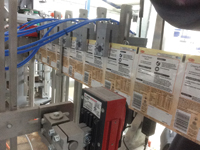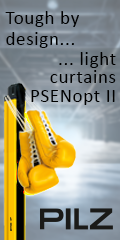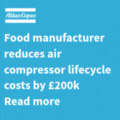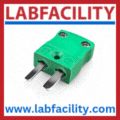
Posted to News on 23rd Apr 2018, 00:00
Quality checking at high speed with high performance cameras
The packaging machine experts from SN Maschinenbau have rethought the entire concept of a bag-filling system used at notable companies in the food industry, tackled this subject innovatively and have opted for the smart camera technology for verifying codes and expiration dates.

Whether sauces, snacks or ready meals have to be filled and packaged, high throughput and quick format changes matter in the packaging systems and food industry – and to the highest standards of quality and hygiene, too. For this purpose, the sensors used have to be able to do one thing above all: meet high demands for power, flexibility and hygiene all at the same time. To do this,
When developing the new FMH 80 forming, filling and sealing machine, the designers from SN Maschinenbau came up with a complete solution for various tasks using one single camera system. They scrutinised existing processes and principles and sought new, creative and flexible solutions. The objective was to make the monitoring of the expiration date economical on the one hand, and to identify reference codes on the other, with the latter function even being able to changeover automatically when products are changed.
A third application using the same camera measures the position of the print mark on the packaging with the output of an actuation variable [mm] to a servo drive and adjusts the sealing stations of the vertical sealing seams in the process. As a result, the pressure fluctuations on the packaging are automatically corrected.
The result is quite impressive. “An innovative design concept came out of this which provides the basis for a new generation of bag packaging machines,” says Thomas Berger, head of electric development at SN Maschinenbau. With the new machine concept, an open, hygienic machine design with reduced component sizes was realised, and without hidden points and edges, thus enabling very simple cleaning. At the same time, increased customer requirements in terms of hygiene and allergy containment were able to be addressed.
“The first task was the verification of reference codes,” explains Michael Fahr, sales specialist at Leuze Electronic. The products and recipes programmed in to the machine are changed directly via the control, without any manual intervention from staff. “In addition, quality control to check the right contents are actually being filled in the right packaging intended for it must be provided every time,” adds Fahr.
To this end, visualisation optics are required which will read the reference codes and match them at the same time. Otherwise, customers could end up getting a carbonara sauce in the package displaying a picture of their favourite Bolognese. The newly introduced visualisation system is a camera-based technology. This becomes an absolute high-end solution in combination with the employed KRTM20 contrast sensor, which can save different contrast values of print marks on the packaging, which can be accessed directly from the control. “Such a convenient, and at the same time, economical solution had been in my mind for a long time. But up until now, I had not yet found a way to make this a reality,” Thomas Berger.
In the past, either reference codes could be detected, which were depicted in the form of a bar code, or 2D-codes. “In order to be prepared for the future tasks of our customers, it is important to have a solution for bar codes, data matrix codes and QR codes simultaneously,” points out Berger. For this problem, too, Fahr had a solution for him with the smart camera, because the LSIS 462i is a multi-code-capable high-speed reader which can detect different types of reference codes. The check takes place while the packaging is moving at a speed of up to 4 m/s.
Another challenge in this application is posed by checking the legibility of the expiration date labels. If expiration date codes were printed in poor quality in the past, the data was illegible due to misprints in the packaging system or the print was missing completely, such bags would only be able to be detected in this high-speed application with very expensive systems. By contrast, the new smart camera technology evaluates the expiration date labels on every single bag by means of several quality features – both at a standstill and when moving at up to 4 m/s.
A second LSIS 462i detects the quality of each and every code in the same way and also performs a reference code comparison, so that the packaging actually contains what it proclaims. “Last but not least, clear legibility of the expiration dates is also down to the homogeneous lighting integrated into the LSIS 462i,” adds Fahr. Due to its integrated LEDs, the new camera-based visualisation optics are highly independent of ambient light and can be specifically adapted to every conceivable packaging design. Its focus can also be changed automatically in motor-driven fashion. Changes to packaging characteristics can be conveniently stored in recipes and accessed with the machine recipe by the user.
The stationary LSIS 462i from Leuze Electronic employed in this application combines expertise garnered over several decades from the field of 1D-code reading with innovative smart camera technology. It reads bar codes, 1D-codes and 2D-codes reliably, both printed and directly marked. At the same time, it detects expiration dates. The measurement technology at the core of the smart camera can have the results of measurements incorporated into the process, or provide adjustment assistance for format changeovers by quickly finding the position of the print mark. The user is shown the directions of the necessary adjustments. Three tasks are thus fulfilled with just one camera model.
Compared to OCR reading, this represents an efficient and cost-effective solution for high-speed applications. Due to its memory function, the KRTM20 contrast sensor can also save up to 128 contrast values at the same time. This means quick product changeovers, thus higher throughput is also possible in terms of print mark control. Owing to its integrated, homogeneous and highly ambient-light-independent LEDs, the LSIS 462i can be flexibly adjusted to the most diverse packaging designs.
The smart camera can easily be integrated by means of a reproducible mechanical mounting bracket, designed by SN Maschinenbau. Reference code specification and program changes are provided directly from the control, without any manual intervention necessary. Mechanical intervention, or even opening the camera, is also not required when the focus has to be adjusted. Even this takes place fully automatically. An integrated display makes possible the diagnostics for the commissioning and alignment during operation directly on the device.






